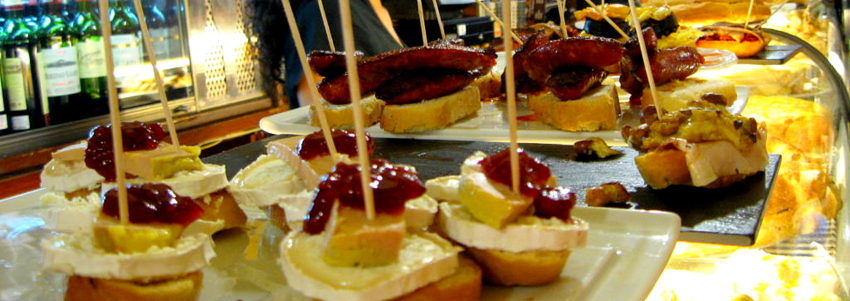Breakfast
Spanish hotel breakfasts (desayuno) are usually continental breakfasts – a roll with jam, butter and coffee. We ask all of our hotels on tour to supplement our breakfasts on tour with cereal, yogurt and cold-cuts. When you are out on your own you can stop by any bar to have tea (té) and coffee (café) and have a toast (tostada) or you can get extra breakfast supplies at the grocery store.
Coffee comes with various amounts of milk. To order an espresso-style coffee, ask for café solo. For espresso with steamed milk, ask for café con leche. Cappuccino does not really exist in Spain, although some bars will give you café solo with whipped cream on top. If you’d like a smaller, more potent shot of café con leche, ask for cortado a café solo “cut” with a small amount of milk. If you prefer your coffee less potent, ask for café americano.
Bars may also have chocolate, which is a very thick hot chocolate eaten for breakfast with churros (fried doughnut sticks). Bars also offer sweet pastries and often small sandwiches. Buy fresh bread, pizza or stuffed croissants at a bakery or bread shop (pastelería or panadería). Fresh-squeezed orange juice is also available. Also common for breakfast or mid-morning snack is the Spanish tortilla (potato omelette). A pincho (slice) of tortilla and a café con leche with a glass of orange juice is a great mid-morning snack.
Lunch
For a quick lunch (almuerzo) on the road, most bars have ready-made sandwiches. You can also get chips, ice cream and something to drink. An alternative is to have the delicatessen in a grocery store make you a sandwich. If they are not too busy they will gladly make a sandwich with cheese or ham. Jamón york is the style of ham Americans are used to, while jamón serrano is more similar to prosciutto. The other option of course, is to buy your own supplies for a picnic lunch (bread, a hunk of cheese, some tomatoes, olives, fruit, etc.).
If you seek a more traditional Spanish lunch (comida), look at any restaurant window’s daily menú for a lunch that sounds good. A menú lets you choose between several options for your primero (first course of soup, salad, pasta, or vegetables), your segundo (entrée of meat or fish) and dessert. The price includes bread and either wine or water. Coffee may be included in the price, and can usually be substituted for dessert as well. Typically, a menú costs around € 9 – € 15 (status 2017) per plate and is the most economical and typical way to eat. Although often a filling meal, options usually allow lighter choices that won’t weigh you down the rest of the day. Restaurants serve this meal from 1 – 4 pm.
Meat and seafood are a focus of most meals in Spain, but vegetarians have many options of pasta, rice, revueltos (scrambled-egg dishes) and legumes. Catalonia is known for its avant-garde cuisine, be ready to be dazzled. Cuisine also varies widely by region and you might discover styles and dishes that are new or unusual, like rabbit.
For snacks along the way, bars or grocery stores can offer helado (ice cream), coffee, pastries, chips, fruit, juice and water.
Dinner
Dinners are late in Spain and most restaurants don’t open before 9 p.m. While on tour, we schedule dinner as early as possible within local boundaries but this usually means 8:00 to 8:30 p.m. Because of the late timing we encourage you to take the opportunity to explore the local tapas or pintxos scene – the Spanish version of an informal happy hour with an abundance of snacks (that are oftentimes free, also depending on the region) and the chance to mingle with the locals.
